More information about this website & why it was created can be found by visiting this website's "front" pages (link opens in a new window)
A series of pages which look at different types of passenger trains
as defined by the type of service they are designed to provide.
Long Distance InterCity Trains looks at trains which are designed for InterCity express journeys with journey times usually in excess of 45 minutes and possibly lasting for many hours. This includes super-fast very high speed trains and tilting trains.
Medium Distance Trains looks at different types of trains that provide medium distance services, typically with journey times of between 30 and 90 minutes in duration, but sometimes longer too.
Short Distance Trains looks at trains designed for journeys of anything from less than a minute up to about 45 minutes within urban areas and their close hinterland. These trains could be operated by either a mainline railway company or a city-specific regional transport authority. Included within this remit are Automated 'Driverless' Metro Systems and Trams, Streetcars and Light Rail Vehicles; however to avoid making a very large page the latter two topics have their own dedicated pages.
"Walk-through" Trains looks at the need to be able to walk from carriage to carriage along an entire train's length, this being an aspect of train design where practical day-to-day passenger requirements are often compromised.
On-train Refreshment Facilities, Double-Deck Trains, & Taking Bicycles On Trains looks at three specific aspects of railway operation which transcends all the other categories as described above.
This section looks at the different types of trains that provide medium distance services, typically with journey times anything between 30 and 90 minutes in duration, but sometimes longer too.
The term 'medium distance' covers a wide variety of different rôles such as:-
As a general theme the trains that provide these services can be divided into two smaller sub-groups which will define the trains' door layout and internal seating arrangements.
Outer-suburban trains will usually feature two sets of twin sliding passenger doors along the carriage side. This is to allow for faster boarding / alighting at station stops but also means that if, in the winter, the doors are open for a long time there can be a rapid loss of heat in the passenger compartment. Conversely, in the summer the extra ventilation is usually welcomed!
Regional express services will usually feature a single sliding door located near to each end of the carriage, as is usual with long distance InterCity trains.
Internally outer-suburban trains will usually feature high-density 3+2 seating, albeit with 'more comfortable' seats that those used on inner-suburban trains. Meanwhile, regional express trains will usually have plusher InterCity style 2+2 seating with a mixture of 'airline' and 'around table' formats (quoted seating configurations are for 'standard' class, first class usually differs).
Medium distance trains are usually equipped with toilets and sometimes feature refreshment facilities too (either a buffet counter or refreshment trolley).
 |
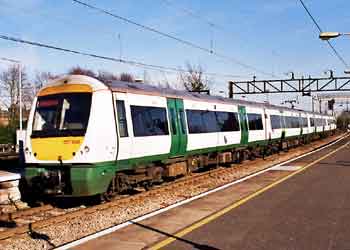 |
||
| Designed for regional express workings this train features single leaf doors nearer the ends of the carriage. | Designed for outer suburban workings this train has two pairs of double doors situated at roughly ¼ and ¾ along the carriage side. | ||
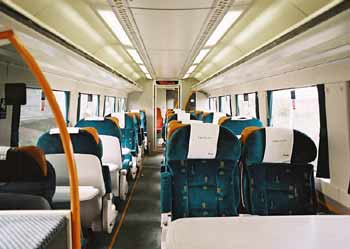 |
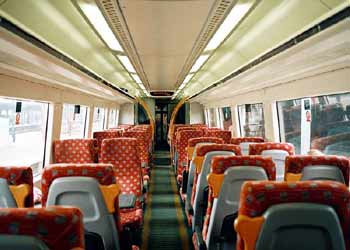 |
||
| Whatever the train's door configuration it is also possible to vary the seating arrangements to suit the service the train operator
provides. This train is mainly used on longer distance services so it features InterCity type seating. The above images show First class left and Standard class right. |
|||
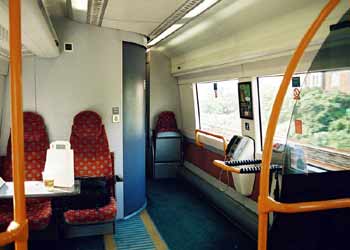 |
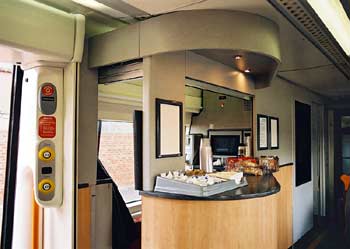 |
||
| Being a brand new train it was designed to feature many wheelchair friendly facilities, including locking devices, space at tables, a telephone that is within easy reach and accessible toilets. | This train also features a small buffet counter for light refreshments which passengers are expected to take back to their seats
to consume. As is usual in Britain hot drinks must be taken in a carry bag. On-train refreshment facilities are looked at on the On-train Refreshment Facilities, Double-Deck Trains, & Taking Bicycles On Trains page. |
||
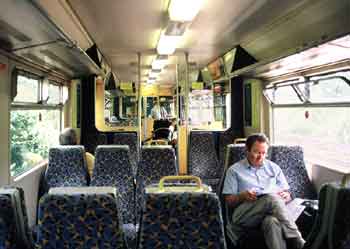 |
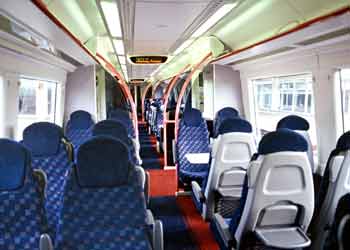 |
||
| 3 + 2 seating inside a train on the 'Thameslink' service that forms an outer-suburban service linking several towns to the north of London with the south coast via Central London and Gatwick & Luton Airports. | Most medium distance trains offer both first and 'standard' (ie: second) class accommodation however one rail operator has abolished 1st class on some of its trains and instead designates the whole train as 'Club' class. | ||
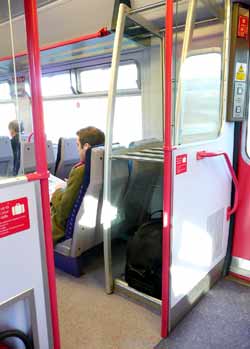 |
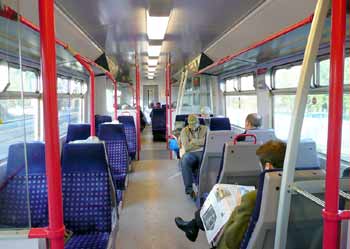 |
||
Since the photograph above left was taken the Thameslink trains have been refurbished, and because of severe overcrowding during the busiest times it was decided that (rather than run more and
longer trains) more space would be created for standing passengers by removing some of the seats. Therefore these carriages now offer a mix of 3 + 2 and 2 + 2 seating. In addition, to try and reduce conflict between standing passengers and
passengers with luggage (these trains serve two busy airports to the north and south of London) the opportunity was taken to create dedicated 'low level' luggage areas which would neither block the doorways nor impinge upon standing space.
Until November 2005 some routes in southern England still used the older 'slam door' trains that were first built in the early 1960's. Despite their demise the trains are included here because they offered some passenger - enticing features which many advocates would suggest could / should have been included on their replacements. These trains operated on two different types of service - express and outer suburban. The express trains offered passenger accommodation similar to what in the early 1960's was standard for long distance InterCity trains. Despite being of an "old" design many people regard(ed) the seating configuration designs of that era as representing the pinnacle in train seating design - this being is mostly 'open' seating (with seats correctly matched to train windows) but also with some compartment seating and two or three sets of single doors spaced along the carriage sides (one each side at both ends and on some carriages one each side in the middle as well). The outer suburban trains were also used for high capacity commuting into London as well as 'inter-urban' services and featured high-density fully upholstered bench-type seating which oftentimes was more comfortable than the seats on more modern trains. Usually the seating bays were arranged around a hand-operated door - this arrangement provided a significantly higher seating capacity than is possible with modern "sliding door" trains and facilitated faster boarding / alighting at station stops (providing alighting passengers remembered to close the doors after getting off - otherwise the train would be delayed whilst the guard did it) but especially in winter could be rather draughty from badly fitting door seals. |
|||
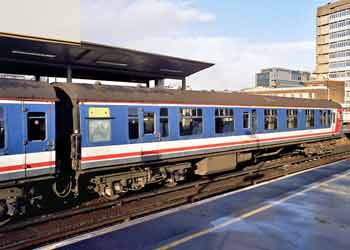 |
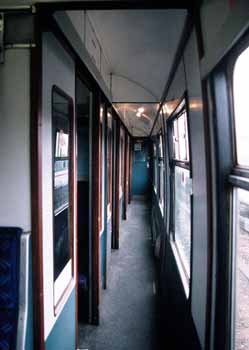 |
||
| External view of an express train. | The side corridor walkway. | ||
Unlike most modern trains these trains offered passengers a choice between open seating and the traditional compartment (with side corridor walkway). The compartments featured heating and lighting controls which passengers could adjust to suit their preferences as well as luggage racks, an opening window and either blinds or curtains so that passengers inside the compartment could enjoy some privacy from those walking by (both unfortunately removed by the time these photographs were taken). |
|||
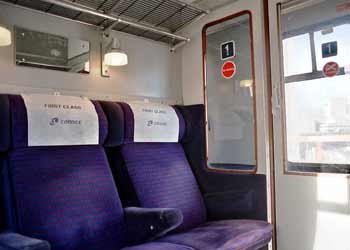 |
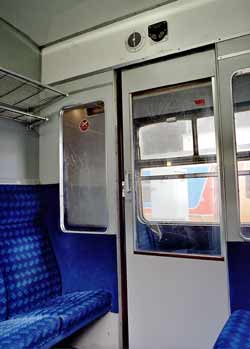 |
||
| Left: - First class, with 3 aside seating, fold-up armrests and individual reading lamps. Right: - Standard class with no armrests and 4 aside seating. |
|||
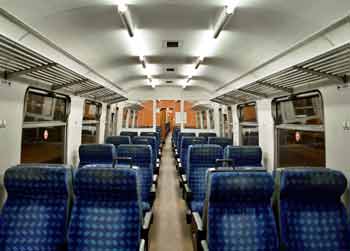 |
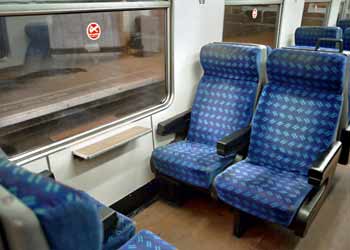 |
||
| Inside an 'open' carriage on an express train showing how all the seats were arranged in bays around the large picture windows where the lower sill is low enough for a seated child to see out of the window. Note the "mini" tables under the windows which are ideal for a cup of coffee (from the refreshment trolley, as regrettably in the latter years these trains no longer had proper buffet carriages), but not much else. | |||
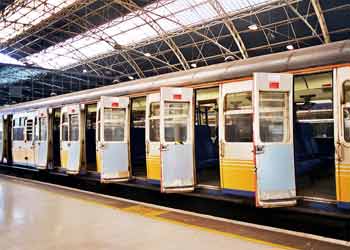 |
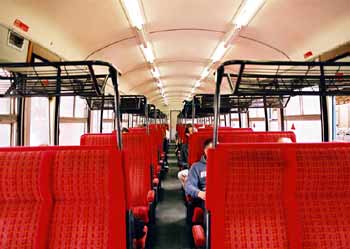 |
||
| Especially at termini stations (as here) few passengers bothered to shut the door when leaving the train. The closely spaced doors identify this as being an outer suburban train. | Inside outer suburban train with comfortable 3+2 high-backed seating and luggage racks over the seat backs. | ||
 |
 |
||
| These trains were built with a small section dedicated to freight (accessed via the double doors) and next to it a guards compartment. The guard's door had full length handles and below it on the carriage underframe were some steps so that the train could be accessed from the trackside. | In their latter years the carriage of freight was discontinued (for instance: the express parcels service ceased trading) but the space became an invaluable asset to passengers who wished to travel with their bicycles. A passenger-friendly feature which very few modern trains offer. | ||
With journeys that can exceed an hour London Underground's Metropolitan line also qualifies as a medium distance service. The trains however are designed for short distance urban metro services and to maximise standing space for short distance passengers travelling over part of the heavily trafficked inner-city Circle Line there is a 32% reduction in seating capacity compared with the trains they replaced. In addition, timetable changes introduced concurrently with the new trains mean that most of the longer-distance off-peak journeys now call at all stations (13 instead of 6 intermediate stations) which adds about 10 minutes to overall journey times. |
|||
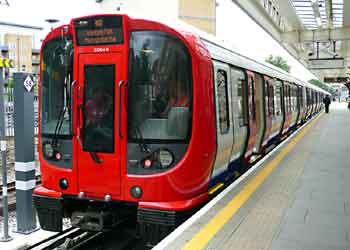 |
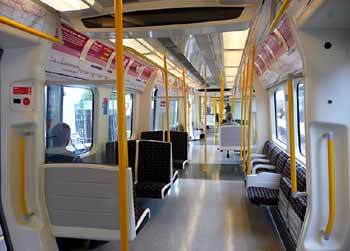 |
||
| Metropolitan line train at Watford Station. | These trains feature airconditioning a mix of inward-facing (longitudinal) & transverse seating and are of a fully walk-through design. There are also dedicated wheelchair spaces. | ||
The primary aim when planning these trains was to fulfil a long-felt desire to create a one size fits all type of train for all the London Underground subsurface lines. They were introduced to Metropolitan Line services between 2010 and 2012. At the time passengers were less than happy because there are only 304 seats per train, compared with 448 on the previous trains and they feel that having to stand as if in 'cattle' class (especially when paying what effectively are premium rate fares) is just not unacceptable. The transport operators claim that to provide similar seating capacities to the old trains they will increase the service frequency, however as there are times when the system is already operating at full capacity it is very doubtful whether this will be possible. As the mainline railways have already learnt (the hard way) trying to run a system at full capacity leads to congestion, not higher capacity. (Operation Princess, on Virgin CrossCountry, which was solved by service reductions, with the resulting passenger disbenefits leading to some severe overcrowding and some 'would be' passengers switching back to the roads). What may also be pertinent here is that the outer reaches of the Metropolitan Line extends a fair distance away from London, and the transport operator says that since its primary remit is for short(ish) distance urban transport - and these locations are outside of the areas in which it can be held accountable at the ballot box - so it does not see why it should offer anything better. This is a very different attitude to that of the former private Metropolitan Railway which even ran Pullman Cars that offered freshly cooked hot food on some of the routes these trains now serve. As an aside, some regular passengers also complained when the previous trains were introduced, because they too provided significantly fewer seats per train than the locomotive hauled (and multiple-unit) hand operated slam door trains they replaced (for instance: the slam door trains on the Watford service seated 600 passengers whilst the replacement trains seated just 448 passengers). The Short Distance Trains page includes suburban trains from Copenhagen and Paris which represent a significant re-write of how trains could be designed, in the process pointing to solutions which if London had adopted could have seen the retention of a high seating capacity - as well as provide ample space for passengers who have 'special needs' and rush hour crush loads. Examples from European trainsSome examples from European trains which operate on regional express services linking smaller towns and cities, on routes not served by full InterCity services. |
|||
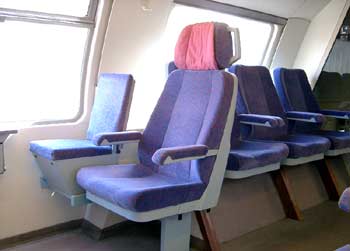 |
 |
||
| This example comes from the upper deck of a double deck train, the longitudinal seating is next to the stairway down. Note the childs seat next to the window. Maybe though, if there are two (or more) children they will fight over gets to sit here? | A 'super compartment' (designed to feature four rows of seats, instead of just two) on a single deck train - admittedly this is for First Class passengers but the concept demonstrates an alternative to both the traditional compartment (which typically seats just half a dozen passengers) and the fully "open" passenger saloon. | ||
Also qualifying as a 'medium' distance train are the light rail vehicles (trams) of the German city of Karlsruhe. In fact there are two different types of tram which are relevant to this page - one operates over a former steam railway line that was electrified and integrated in the town's urban tramway system and the others are dual-voltage trams which outside the urban area operates regional 'all stations' services over routes shared with mainline trains, whilst in town they share the pre-existing (and, in some places, newly constructed) tramlines to operate through city streets also used by the general road traffic and through pedestrian-only shopping zones. |
|||
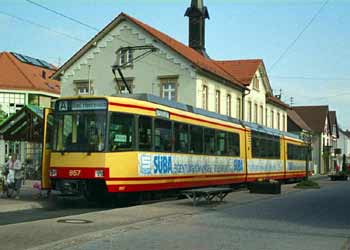 |
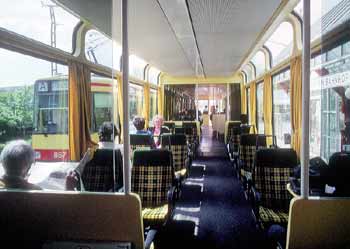 |
||
| Yes its a tram! - but designed for longer distance services through the Black Forest Technically these tramcars are for 'standard' class passengers only, however their internal ambiance is more reminiscent of first class! They feature very comfortable 2+1 seating, window curtains and (in the centre section) panoramic windows which give passengers a grandstand view of the surrounding countryside. |
|||
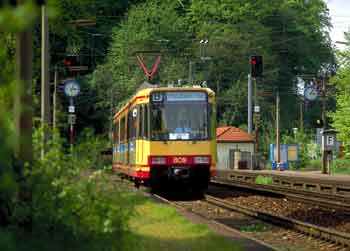 |
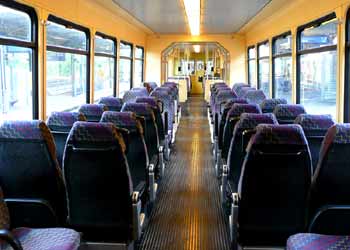 |
||
| These dual voltage (15,000v ac & 750v dc) InterCity TramTrains use mainline rail lines and city street tracks to provide cost effective - and
very popular - 'all stations' stopping services over InterCity and rural routes linking several regional towns with the German city of Karlsruhe. To help them fit in with
other, faster trains these TramTrains have a very respectable (for the type of vehicle) top speed of 100km/h (approx 62 mph). The internal view has been angled to show the inward facing seats.
At one time some of the services provided by this still-expanding network were listed for closure / abandonment; yet once it was realised that replacing ordinary local trains with tramcars such as these resulted in increases of passenger numbers of as much as 500% a solution which both increased ridership and reduced operating costs became evident. Maybe there is a lesson here for us in Britain too? |
|||
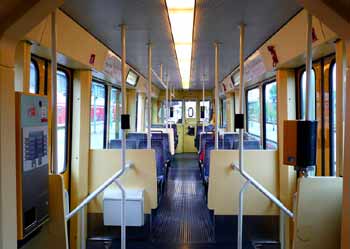 |
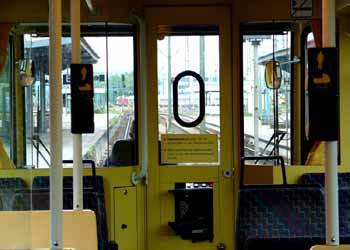 |
||
Although passengers are encouraged to buy their tickets before travelling there are times when such is not possible and recognising this these TramTrains have
been fitted with ticket selling facilities. Preferably the passengers will use the ticket machine (as seen on the left edge of the image on the left) however as a solution of last resort they
can pay the driver - as the image above right shows, the cab door includes a window through which passengers can discuss their ticketing requirements, a coin return chute plus other facilities.
There are many people who see many advantages in using modern trains of a lighter weight (or mass) on quieter, sometimes rural lines which have a national or local strategic value but are not necessarily profitable. The advantages of light rail vehicles (or those as seen below) are that their lower weight reduces wear & tear on the tracks, thereby reducing maintenance costs, and making the services cheaper to operate. In some instances the local communities are a short distance from the stations which claim to serve them and especially with 'street compatible' vehicles it would even be possible to bring the services right into the town centre by installing short deviations away from the existing railway and through the urban streets. Experience in the Karlsruhe area has shown this to be a very popular - and successful - solution. Elsewhere in Germany a similar philosophy is being followed too, in some cases with local diesel trains or twin system trams which are electric in town and diesel - electric when travelling over non-electrified rail lines. It is important however that on routes also used by freight trains everything is done on the basis of continued access by the freight trains - passenger vehicles such as those in Karlsruhe or on the Tyne & Metro were designed to be suitable for use on tracks shared with non-passenger trains. The concept of using light rail vehicles to replace mainline trains for in this way is looked at in greater detail on the Track & Route Sharing and the Investment, Disinvestment & Future Solutions pages. |
|||
 |
 |
||
| These air-conditioned trains are used in Norway, Germany, Austria and Canada either in electric or diesel electric form. Designed for regional and suburban services they are fully walk-through (within the train) and like many new european trains include an area of tip-up longitudinal seating as this makes space for "personal wheeled transports" ie: pushchairs, bicycles, etc. Seen in Salzburg, Austria. | |||
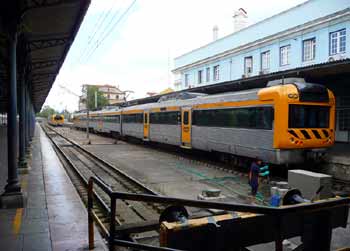 |
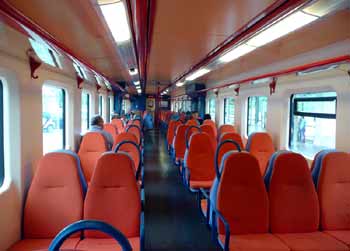 |
||
These Portuguese air-conditioned trains are used on urban, suburban and regional services on electrified routes in northern Portugal.
They feature two single doors per carriage and plenty of 3+2 seating. They were seen at Coimbra A station.
High Speed Medium Distance TrainsAs more and more dedicated high speed sections of line are built to reduce journey times on long-distance InterCity services, so some politicians and railway operators have recognised that it makes political (especially at election time) and economic sense to take every possible advantage of the new lines by using them to speed up shorter distance services too. For some journeys the reduction in journey time will be significant. In some instances the faster trains can make journeys 'commute-able', which means that it becomes viable to live in a community (usually a town or city) further away from where a person works and still benefit from reasonable journey times when travelling to / from work. Whether this is always beneficial from energy use / demographic points of view is debatable, however since these issues have applied to the railways (and more latterly the roads as well) ever since mechanised transports began the new higher speed services only represent a next stage in an ongoing policy. Two countries which have done this are Spain and Britain. However doing so has resulted in 'side effects' which have not pleased everyone....
|
|||
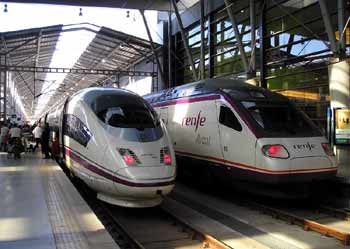 |
Spanish 350km/h (217mph) AVE Class S-103 train (left) at Malaga, Maria Zambrano station alongside a medium distance 250km/h (155mph) Avant Class S-104 train which operates journeys that typically are between 30
and 90 minutes in duration.
Image & license: Glucke / Wikipedia encyclopædia. CC BY-SA 3.0 http://commons.wikimedia.org/wiki/File:Ave_Class_103_and_Avant_Class_104.JPG. |
||
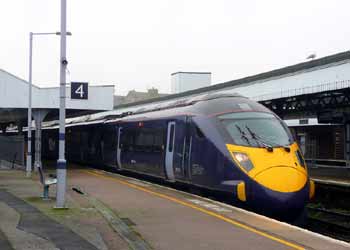 |
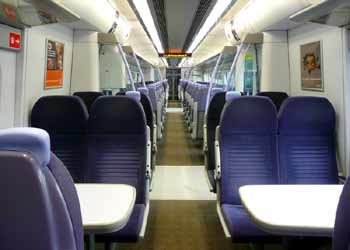 |
||
Southeastern "Javelin" train at Margate railway station. These trains operate on both the existing 3rd rail electric network (at normal speeds) and on the Channel Tunnel high speed line (HS1) which they share with the
186mph (300km/h) Eurostar trains. However, although designed for 140mph (225km/h) they only normally exceed 125mph (201km/h) when running late. At the back of the first carriage it is just possible to see the folded pantograph, which is used
when travelling on the high speed line. Also note the two extra-wide single leaf doors. Internally these trains feature a mix of some sets of facing seats around tables plus (mostly) airline seating. From experience it is regretted that the
seats are not more comfortable*. The folding armrests and power supply sockets for laptop computers are nice additional features.
My own personal impression from travelling on a Javelin train: I found the seats to be very uncomfortable, the seat back pitch was too far reclining for me trying to read a magazine placed on the table and the seat squab was inclined in such a way that I was constantly sliding downwards towards the floor. In fact I had to brace myself with my feet. Whilst for short distance urban journeys the seat comfort 'quality' is not of vital importance, however my journey was from London St Pancras to Margate, which took over an hour - and therefore not what could be called a 'short distance' urban journey. Airport Rail Link TrainsAirport Rail Link trains fall into two categories - those which provide dedicated services linking airports to cities and those which serve a wider hinterland with the airport being just one (albeit important) station as part of the entire route network. Trains on the dedicated services will generally shuttle between the city centre and airport stations at high-ish (or even very high) speeds, calling at very few (if any) intermediate stations. Internally they tend to be designed differently to other trains, featuring enhanced luggage facilities to cater for the high number of passengers travelling with heavy luggage. As a contrast, trains which serve a wider hinterland with the airport being just one (albeit important) station as part of the entire route network will have to offer a compromise between the needs of the air travellers and those of the regular (local area) travellers. Typically that will mean nothing more than their having a little extra luggage space. This section does not look at these trains. |
|||
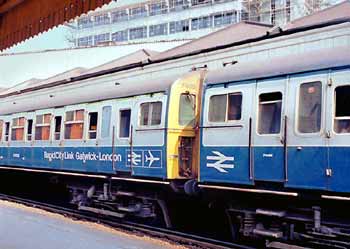 |
 |
||
| At one time London's Gatwick Airport was served by extra carriages branded "Rapid City Link Gatwick - London" which were coupled to regular trains for the journey between the airport and Central London. | Nowadays the highest profile service is provided by dedicated non-stop express trains. When the Gatwick Express was first introduced regular passengers were less than happy because it was seen as a priority service which they claimed negatively impacted on all other services using the line. Nowadays some of these concerns have been proven to be correct and to create extra capacity some Monday - Friday rush hour services have been modified to cater for the needs of other passengers too. | ||
|
|||
|
Many of the dedicated airport - city centre railway services charge premium priced fares, apparently of the reasons for this is so as to make them (financially)
unattractive to regular commuters as otherwise the trains would be swamped, leaving no space for the air travellers. This partly explains why on a distance-travelled basis
Londons' prestige Heathrow Express is even more expensive than flying first class - though as a spokesperson from the "International Air Rail Organisation" (IARO)
(which promotes airport rail links) pointed out to me, even with several people travelling together using these trains still works out considerably cheaper (plus significantly
faster) than going by taxi. |
|||
 |
 |
||
| Standard class on Londons' prestige Heathrow Express trains. Note the extra luggage racks in place of some seating - air travellers often travel with heavy luggage so whilst seating is important so is provision for their baggage. | First class passengers have 2+1 seating, arm rests, individual tables with fold-up sections (to ease access into the seats) as well as other niceties such as coat hangers. | ||
Internally the Heathrow Express trains are very well equipped, featuring comfortable seats, plenty of luggage space, provision for special needs accessibility and even aircraft-style seat-back emergency exit information and floor mounted emergency lighting. When first introduced these trains also featured racks of visitor-orientated leaflets and pay-telephones, however as with street-based public telephones the rise in the use of mobile phones (cell phones in American English) will have significantly reduced the need for public telephones. The trains also feature television display units which even on a short 15-minute journey really do make the journey seem to fly. The 'programme' usually consists of a special Heathrow Express edition of the BBC TV news and weather, advertisements, short features and public-information style safety messages - such as messages advising passengers to 'mind the gap' between the train and platform when alighting Having sampled this on-train TV service I strongly feel that for all but the shortest urban journey the television displays really are a good idea - though passengers who wish to doze, read books, work on the laptop etc., might wish for some 'quiet' zones too. |
|||
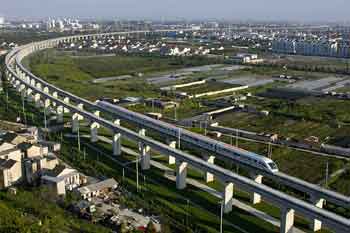 |
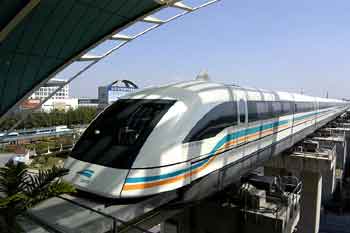 |
||
The first commercial application of high-speed maglev "anywhere" globally is the 30km, double-track line which connects Shanghai to the new Pudong International Airport.
With a peak operating speed of 430 km/h (267 mph), each one-way trip has a duration of less than eight minutes.
Both images sourced from manufacturer's promotional material. A major issue which faces airports is that people who live close to them dislike the associated noise and air pollution which is caused by both the aircraft and the passengers / airport workers travelling to and from the airport. For new airports a possible solution is to locate the airport a distance away from the city - but then the journey times to reach the city centre becomes so extended that it will deter potential passengers. The solution of course is to build a very high speed rail link so that even though the distance travelled may be quite large the journey time will be very short. Since 29th December 2003 a high-speed maglev line has been carrying passengers between the new Pudong International Airport and Shanghai, China, taking less than eight minutes to travel over 30km (a little under 19 miles). Bearing in mind that this journey time also includes acceleration and braking this is very fast! The "Transrapid" system uses German technology and is capable of cruising at 300mph+, although on such a short line that speed is not reached. For more information visit their website at http://www.transrapid.de or http://www.transrapid-usa.com. In February 2005 a consortia put forward proposals for a British Maglev network linking 75% of the British population along the London - Birmingham - Liverpool - Manchester - West Yorkshire (Leeds) - Teeside - Tyneside (Newcastle-Upon-Tyne) - Edinburgh - Glasgow corridor. More information can be found at their website http://www.500kmh.com |
|||
Direct links to other Passenger Train Variations pages.
 |
|||||||||||||||||||||||||||||||||||||||||||||||||||||
 |
|||||||||||||||||||||||||||||||||||||||||||||||||||||
 |
|||||||||||||||||||||||||||||||||||||||||||||||||||||
 |
|||||||||||||||||||||||||||||||||||||||||||||||||||||
 |
|||||||||||||||||||||||||||||||||||||||||||||||||||||